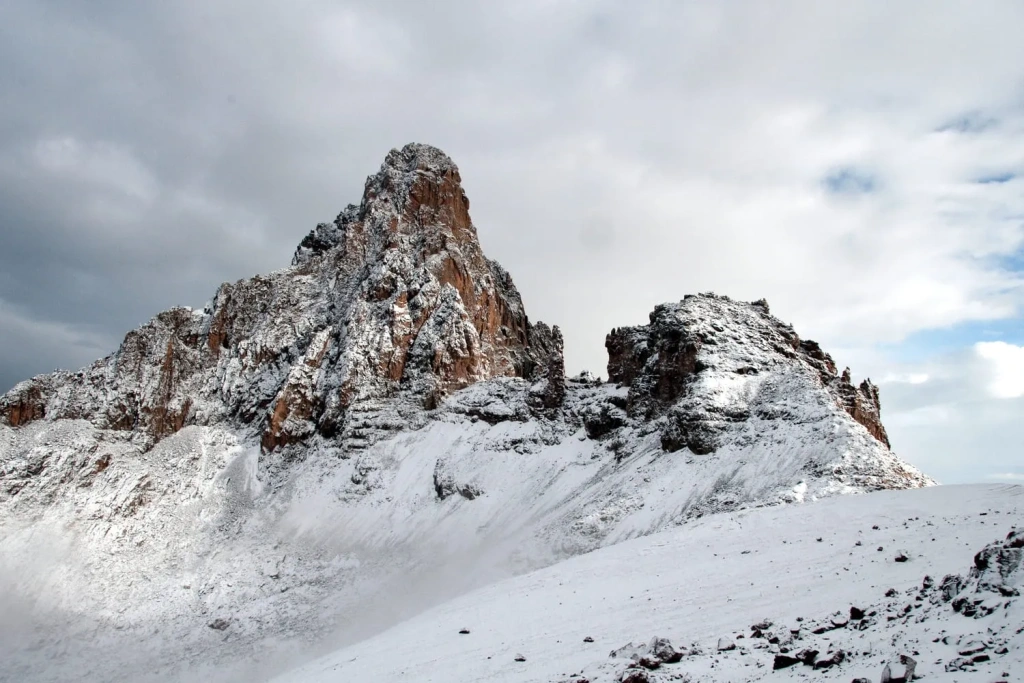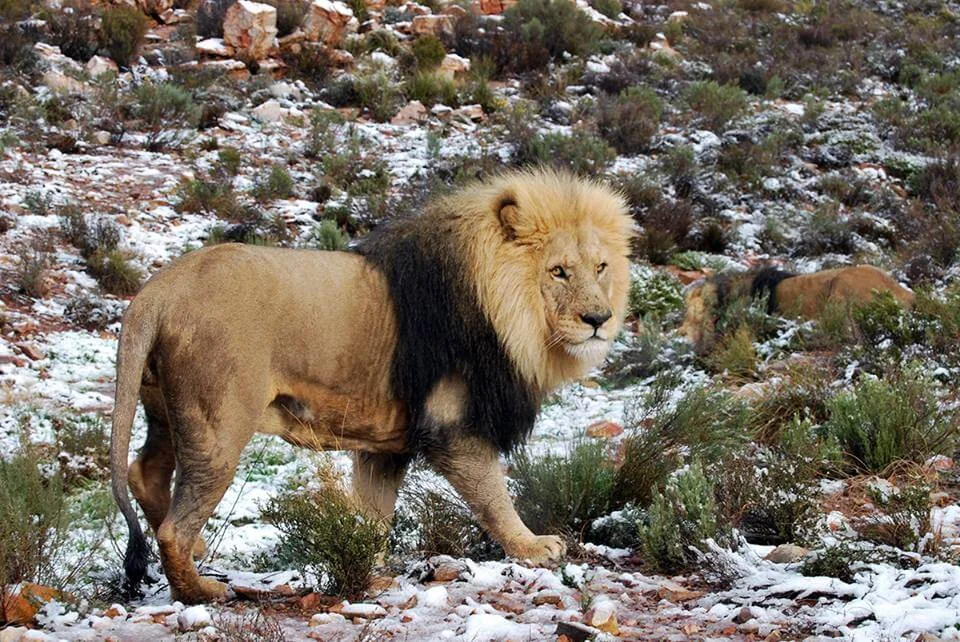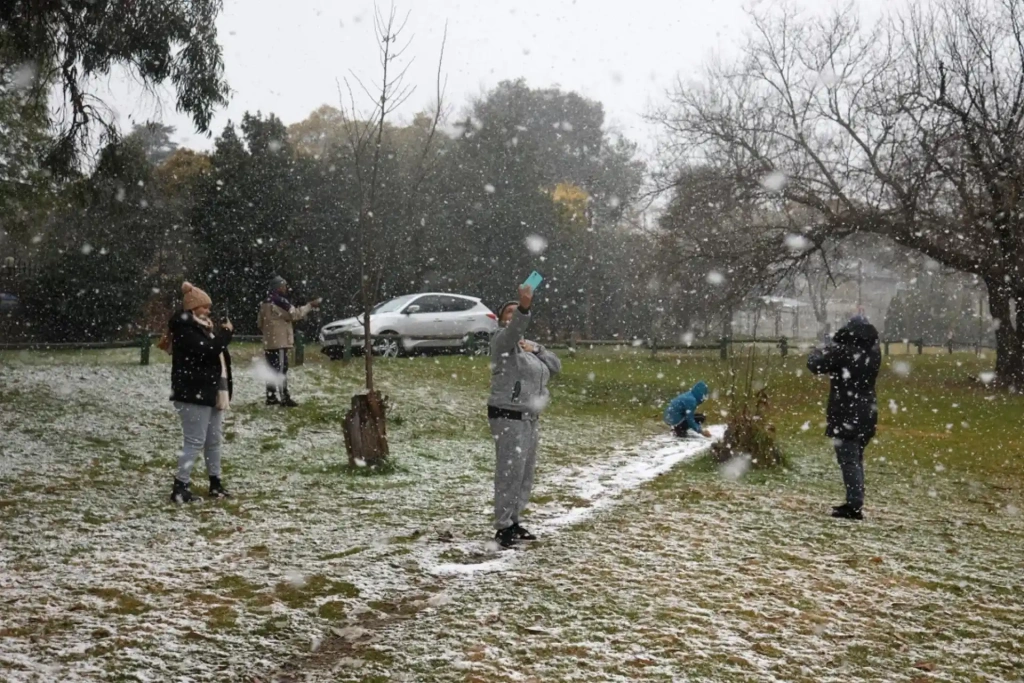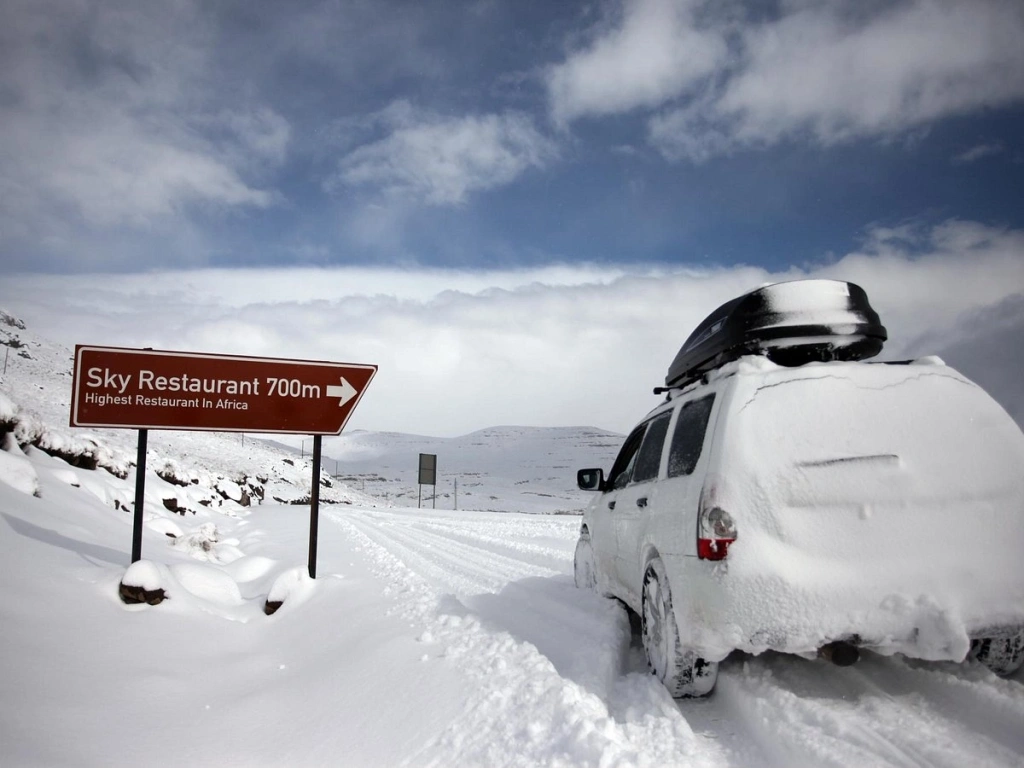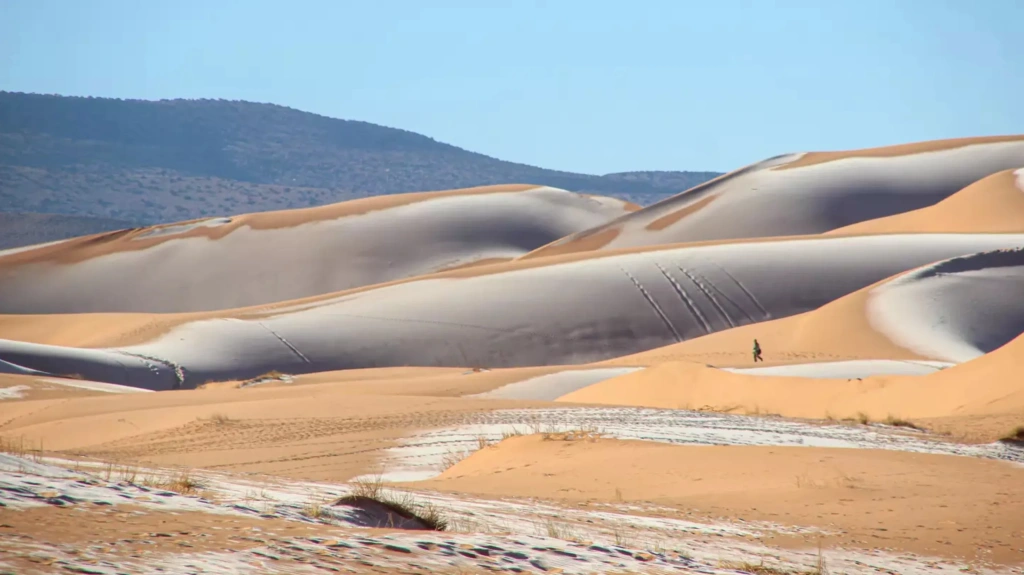Scorching sun all year round, sweltering heat, and drought—this is the image often associated with Africa. However, it reflects reality only partially. The continent encompasses multiple climate zones, where you can find not only deserts but also vast tropical forests, majestic mountain ranges with glaciers, and even snowdrifts. Snowfalls, of course, are rare and are most likely to occur on mountain peaks.
In short, Africa is far too diverse to fit into stereotypical descriptions. We aim to provide a more complete and accurate picture by offering you an overview of the snowiest places on the continent.
Snow in Equatorial Africa. Does Africa get snow?
In the equatorial part of the continent, the climate is hot, characterized by extreme humidity and abundant seasonal rainfall. Snow can be found here at elevations above 4,500 meters (14,764 feet). The best place to look for it is East Africa: on the peaks of Kilimanjaro, Mount Kenya, Rwenzori, and the Simien Mountains.
1. Snow on Mount Kilimanjaro in Tanzania
The tallest mountain in Africa (5,895 meters / 19,341 feet) is located very close to the equator. Mount Kilimanjaro is in Tanzania, within the national park of the same name. Depending on the time of day and the altitude, the weather on the mountain can vary from very hot to extreme cold in a single day.
The high altitude of Africa's highest peak, together with equatorial trade winds, make the climate on the upper reaches of Kilimanjaro quite cool. At the foot of Kilimanjaro, the average temperature ranges from 21–27°C (70–81°F), while at the Uhuru Peak, nighttime temperatures can fluctuate between -7°C and -29°C (19°F to -20°F). If you plan to join an expedition to climb Kilimanjaro, you should prepare not only for warm, comfortable conditions but also for rain, wind, cold, and even snow.

Monsoons from the Indian Ocean meet the mountain, where rising air cools and releases moisture as rain and snow at the summit. The main rainy season occurs from March to May, with a shorter rainy period in November.
Kilimanjaro expeditions run year-round, but climbing is more challenging during the rainy season. The most comfortable time to summit is from late December to early March and from mid-June to late October. Heavy rains dominate the remaining months, and Tanzania's increasingly unpredictable climate makes it difficult to forecast exact conditions. Therefore, it's essential to be prepared for unexpected changes.
2. Snow on Mount Kenya in Kenya
Mount Kenya is located close to the equator, and at its foot lies the town of Nanyuki, where you can find a sign marking the equator's line—an iconic local attraction.
The mountain rises to 5,199 meters (17,057 feet), with 11 glaciers at its peak. From the base to the summit, you’ll pass through various climate zones that can differ dramatically. For example, the southeastern slopes are very wet and covered by dense forests. At the summit, snow frequently falls, feeding the glaciers.
Mount Kenya is the highest mountain in the country and the second-highest in Africa after Kilimanjaro.
Snowfall on the mountain occurs from March to December, during the rainy season. However, you’ll only encounter snow if you climb to an altitude of 4,300 meters (14,108 feet). During the dry seasons, from January to February and July to October, the mountain's weather becomes more stable and sunny. During these months, rainfall decreases to a minimum, and snow is absent. Visibility improves, revealing the stunning glaciers to climbers.
3. Snow in the Rwenzori Mountains in Uganda
In the heart of the African continent, amidst tropical rainforests on the border of Congo and Uganda, lie the snow-capped peaks of the Rwenzori Mountains. It is believed that these mountains were once known as the mysterious "Mountains of the Moon." The name may have originated because their outlines become visible only in the moonlight, while the dense mist of the tropical forest hides the peaks during the day.
The modern name Rwenzori traces back to the local people's language — "Rwenjura." This phrase can be translated as "rain maker" or "king of the clouds," a fitting name considering that it rains in these mountains about 300 days a year.
The Rwenzori range stretches over 120 kilometers (75 miles) and consists of six main massifs. The highest peak is Mount Stanley’s Margherita Peak, reaching 5,109 meters (16,763 feet), followed by Speke at 4,890 meters (16,043 feet) and Baker at 4,844 meters (15,879 feet). The other massifs include Emin at 4,798 meters (15,741 feet), and Jessi at 4,715 meters (15,469 feet), while Luigi di Savoia stands at 4,627 meters (15,180 feet). These peaks are separated by deep valleys covered in dense tropical forests, which are hot and humid at lower altitudes. However, temperatures at the summit often drop below freezing.
Glaciers are found on the slopes of Stanley, Speke, and Baker at elevations starting from around 4,400 meters (14,436 feet), where snowfall becomes more frequent.
In the Rwenzori mountain area, fog and rain are frequent occurrences. However, there are also two dry seasons. The first begins in June/July and lasts until August and the second from December/January to February. These are the most favorable times for climbing.
The entire Rwenzori mountain system was once covered with ice, but today remnants of its former glacial glory can only be found on the three highest mountains, with Stanley having the most. Some data suggests that all the ice on the Rwenzori peaks may disappear by 2030. Stanley is the highest mountain in Congo and Uganda and the third-highest in Africa after Kilimanjaro and Mount Kenya. The northern side of Stanley is blanketed in snow and ice, leading directly to the summit.
4. Snow in the Simien Mountains in Ethiopia
In Ethiopia, there are also separate mountainous areas where snowfall has been observed at different times. However, such natural phenomena are very rare here. The highest point in the Simien Mountains reaches 4,533 meters (14,872 feet). Yet, it is nearly impossible to see snow cover here — it melts too quickly.
Snow in Southern Africa
South Africa is located in the Southern Hemisphere, meaning it is quite far from the equator. Therefore, the seasons here are reversed. Summer comes in December and lasts until February, while winter starts in June and ends in August. It's a land of diverse climates where you also can witness snowfall.
There are two main regions in southern Africa where snow falls somewhat regularly—South Africa and Lesotho. South Africa features a variety of ecosystems: from high mountains to savannas, grasslands, forests, and even tundra. The Kingdom of Lesotho is also noteworthy. This country, entirely surrounded by South Africa, is located at an altitude of over 1,000 meters (3,281 feet) above sea level. Additionally, snow has been observed in sunny Namibia, though significant snowfall here is a rare and lucky event. Let's take a closer look at each of these regions.
1. Does it snow in South Africa?
The short answer is yes, it does. Here's where and when you can find it.
Cederberg Mountains
Located around 300 kilometers (186 miles) north of Cape Town, the Cederberg range in the Western Cape consists primarily of sandstone. The climate here is unique: extremely hot and dry in summer and very wet in winter. While it tends to rain at the foot of the mountains, the peaks are often covered in snow during winter.
In July 2024, snow fell during a safari in South Africa. Although it was winter in this part of the continent, the event was unexpected and surprising. Videos of animals in the snow in Cape Town quickly spread across the internet — lions, rhinos, elephants, and even giraffes with snow caps on their heads and backs caused a wave of shock and delight online.
Sutherland
One of the coldest places in South Africa, where snow in the winter season is quite common, though it only falls about once a month. This typically happens in June, July, and August. Winter temperatures here drop to an average of -2°C (28°F). This cold climate can be attributed to the high altitude, with the region situated at 1,458 meters (4,783 feet) above sea level.
In July 2023, snow fell in Johannesburg, one of South Africa's largest cities. Snow is a rare occurrence in the city, making this event especially notable as it was the first snowfall in over 10 years. Before this, the last snowfall in Johannesburg happened in 2012.
Rhodes
This small village is located in the and experiences a subtropical highland climate, meaning mild summers and dry, cool winters with occasional snowfalls.
Rhodes sits at just over 1,800 meters (5,905 feet). It's also the starting point for the annual winter event, the Rhodes Trail Run. It is a 52-kilometer (32-mile) race across rugged terrain that passes through the Lesotho border and alongside the snowy fields of .
In the Drakensberg, you’ll also find Tiffindell, a South African ski resort where you can ski and snowboard for three months of the year. The South African Mountain Club (MCSA) and the Ski Club of the University of Cape Town have equipped the area with ski huts. Winter sports in the Cape, however, depend on seasonal snow.
Hogsback
It is another small village in the Amatola Mountains, located at 1,963 meters (6,440 feet). The cool oceanic climate here is often compared to English weather, with an average winter temperature of around 3.5°C (38.3°F). Although rare, it does snow here a couple of times a year, thanks to the village's high elevation.
2. Snow in Lesotho
One of the few African countries where snow is not such an exotic event is Lesotho in southeastern Africa. This high-altitude kingdom is entirely surrounded by South Africa, and snowfalls here occur much more frequently than in other African nations.
In fact, Lesotho is the only country in the world where every square meter of land is situated at an altitude of more than 1,000 meters (~3,300 feet). Over 80% of the kingdom lies even higher, above 1,800 meters (~6,000 feet). Some regions exceed the very high altitude of 3000 meters (~10,000 feet). Snow falls most frequently from May to September, and in higher areas, snow can fall almost year-round. This landlocked country is also home to Afriski, the second ski resort in southern Africa.
3. Snow in Namibia
Namibia enjoys more than 300 sunny days per year. Winters here are typically dry, with rainy seasons occurring between September and November and again from February to April. Rainfall is minimal, and extended droughts are common.
Nevertheless, snow has been observed in Namibia, though it happens very rarely. The last recorded snowfall occurred in June 2022.
Is there snow in Northern Africa?
In the northern part of the continent, the seasons are familiar to many of us. Winter occurs from December to February, and summer runs from June to August. The climate in these regions is mostly dry and desert-like, with extreme heat and minimal precipitation. However, at higher altitudes and in the Sahara, nighttime temperatures can drop below freezing. Though rare, snow does occasionally fall in these areas. Notably, snowfalls have been recorded in Tunisia, Morocco, and Algeria during especially cold winters.
1. Snow in Tunisia
Snow in Tunisia is an exception rather than the rule. However, during the winter months, it can get quite cold on the highest mountain peaks. Snowfalls have been observed around areas such as , , and other nearby mountains.
Snowfall in a hot desert may seem unbelievable, but over the last few decades, snow has fallen multiple times in the Sahara desert. The most recent snowfall occurred in January 2022.
2. Snow in Morocco
When talking about snow in Morocco, the come to mind, especially the and ranges. Snowfalls here are quite frequent. For example, the city of Ifrane, often referred to as "Morocco's Switzerland," sits at an altitude of 1,665 meters (5,463 feet) and is famous for its alpine-style architecture and snowy winters. Ifrane is also home to a ski resort of the same name. Another notable ski area is Oukaïmeden, located at 2,600 meters (8,530 feet), where the tourist season lasts from December to April.
3. Snow in Algeria
In this country, the prevailing climate is dry and desert-like, so snow is quite rare. However, part of Algeria is home to the , where snowfalls occur from time to time.
Climate change in Africa
The issue of rapidly changing weather conditions on the continent has become increasingly urgent in recent years. Africa is considered one of the most vulnerable regions in the world, where weather patterns are shifting at an almost catastrophic pace. Such uncontrollable climate variability could reduce agricultural production, threaten food security, and severely deplete water resources.
It is expected that in the next decades, a likely global temperature rise of 1.5°C (2.7°F) will affect nearly the entire planet, leading to an overall increase in average rainfall. However, Africa is currently warming at a faster rate than the rest of the world.
On the graph above, red represents warmer values, and blue represents cooler ones (the average temperature from 1971–2000 is taken as the reference point for these changes). Data source: Berkeley Earth.
All these climate changes have led to unpredictable and capricious weather patterns in Africa in recent years. The glaciers on Mount Kilimanjaro, which have been retreating over the past century, are expected to disappear completely within a few decades due to rising temperatures.
Right now, there is still a chance to experience the magic of snowy peaks rising above equatorial rainforests and hot savannahs. Perhaps the best place to experience this is Mount Kilimanjaro in Tanzania, the tallest free-standing mountain in the world!
All content on Altezza Travel is created with expert insights and thorough research, in line with our Editorial Policy.
Want to know more about Tanzania adventures?
Get in touch with our team! We've explored all the top destinations across Tanzania. Our Kilimanjaro-based adventure consultants are ready to share tips and help you plan your unforgettable journey.


















